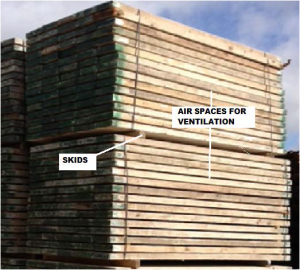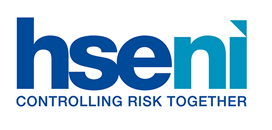
Workers at risk
Following a recent incident on a Belfast building site, HSENI remains concerned about the number of sub-standard scaffolding boards that are still being used throughout Northern Ireland, putting workers at an unacceptable and unnecessary level of risk.
There is a British Standard specification for scaffold boards – BS 2482:2009. Failure of a new board graded to this standard is unlikely when it is first used.
Failures are much more likely to be due to misuse during construction work, for example cutting materials, overloading, or degradation of the board during storage.
HSENI finds during site visits that there are boards in use which superficially look sound, but on closer inspection are found to have been weakened.
Examples of misuse of boards which can cause serious damage include:
- using boards to assist vehicles over soft ground
- driving vehicles over boards accidentally
- using boards as ramps for wheel barrow access
- throwing or dropping boards from heights
- storing heavy objects on boards, for example lifting pallets of blocks on to scaffolding at areas which are not specifically designed loading bays
There are a number of boards in use commonly referred to as Grade A boards which have not been graded to the requirements of BS2482:2009.
HSENI recommends that only boards manufactured to this standard are acceptable. This ensures a consistently high standard throughout the industry.
Boards manufactured to the standard can be identified by a marking on their end bands.
BS2482 requires that the end bands are marked with the following:
- number and year of British Standard
- identification mark of the supplier
- the letter M or V (mechanically or visually graded)
- the word “support”, followed by the target span in metres up to which the board may be supported
- where appropriate, the identification mark of a third-party certification body
The end bands also have an important role in protecting the vulnerable end grain of the boards. They should extend around the edges of the board by at least 150mm for 38mm boards and at least 100mm for 63mm boards.
The bands should be secured with three clout nails into the end of the board and two on each edge.
BS2482 also permits the use of teeth formed in the end band or special long staples to secure the end bands. Damaged end bands can leave sharp edges which can cause cuts when handled.
It is vital that all scaffold boards are checked regularly for damage, rot or any other feature which may reduce the strength of the board. BS 2482 provides guidance and limits on the acceptability of defects in scaffold boards. Any board which fails one or more of the inspection criteria in BS2482 must be destroyed.
Boards must be cleaned prior to storage and inspection. Check for surface contamination of the board such as chemicals or cement. If you can’t clean it and inspect it properly, then the board should be destroyed.
The following describes some of the common defects occurring in scaffold boards, but is not comprehensive.
Fissures (shakes, checks and splits)
BS2482 sets a limit for fissures on the face of boards of 225mm length, and 12mm or more in depth. Careful attention should be paid to splits in the ends of boards which can be partially hidden by the end bands, but may pass through the full thickness of the board.
Wane
The standard permits a limited amount of wane (a rounded edge caused by the curvature of the log from which a board has been cut). The limits on wane are 25mm on the face of the board, and 12mm on the edge of the board.
Mechanical damage
If the board is damaged to an extent that will reduce its strength, or is likely to cause unsafe footholding, or an injury whilst handling the board, then it should be destroyed.
In normal use a board’s top face on one job may become its bottom face on the next job. Mechanical damage may occur on the first job but the failure may not happen until the board is turned and loaded in the opposite direction.
The user causing the damage may not witness the failure and is unlikely to be aware of the consequences of their actions.
Common examples of unacceptable damage include:
- broken or damaged end bands
- wood broken from the edge of the boards which significantly reduces the cross-section of the board
- loose or broken knots
- damage caused by being struck by the forks of a forklift truck
- excessive cuts in the faces of boards caused by hand saws, circular saws or angle grinders
- transverse cracks caused by overloading
Distortion
As scaffold boards are exposed to all types of weather, the wood is exposed to sunlight as well as cycles of wetting and drying, which can cause boards to distort.
A distorted board is a dangerous board, as it can move in service. The standard sets limits on cup, bow, spring and twist. If any board exceeds these limits it should be destroyed.
Insect attack
If a board contains wormholes or wood wasp holes or if there is an infestation of the timber then the board must be destroyed.
Fungal decay
Fungal decay, usually wet rot, is common in poorly stored scaffold boards. Wood is vulnerable to attack when the moisture content is over 20 per cent. It can be detected by discolouration of the wood, which also becomes softer – you can easily push a finger nail into attacked wood.
Rot often starts at cracks or around knots in wood because these areas are wetter as water is retained in the cracks. The boards will also often smell musty.
A decayed board loses weight and so will feel lighter than an equivalent sound board.


In the early stages of decay there is a minor loss in bending strength or stiffness, but there is considerable loss in resistance to impact loads, for example, a worker jumping onto a board, or lifting a heavy sill. In the later stages of decay large holes filled with soft decayed wood appear. The rotted wood has transverse cracks in the wood fibres and the material crumbles easily.

Decay in your boards can be reduced by storing planks properly when not in use. This is particularly relevant in these economic times when large quantities of scaffolding may be stored for longer periods of time.
Boards should be stored preferably under cover and clear of the ground. Spacers must be used between each layer of stacked boards to allow an adequate flow of air around the boards to dry them out.
Recommendations
The head of HSENI’s Construction Team, Nancy Henry, recommends that you ask yourself, “Are you confident that the boards used by your workers are fit for purpose and comply with the legal requirements?”
Check to see if the scaffold boards you are using comply with the following:
- all scaffolding boards conform to BS 2482:2009
- they are cleaned prior to inspection
- they are not damaged in any way
- all boards in storage are stacked in a way which allows for ventilation
- all boards are inspected before installation and at regular intervals thereafter
- where machine testing is carried out ensure that boards are tested in both directions
For more information, please contact Fiona Watt, as follows:
- fiona.watt@hseni.gov.uk
- 028 9054 6876
Latest news
- Essential Maintenance 24 April 2024
- Urgent - Farmers be aware! Recent near miss with slurry gas 23 April 2024
- Latest chemicals news for Northern Ireland - updated 22 April 2024 22 April 2024
- Dungannon company and driver fined following death of employee 10 April 2024
